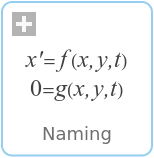WOLFRAM SYSTEM MODELER
NamingNaming convention |
|
Wolfram Language
In[1]:=
SystemModel["Modelica.UsersGuide.Conventions.ModelicaCode.Naming"]
Out[1]:=

Information
This information is part of the Modelica Standard Library maintained by the Modelica Association.
- Class and instance names are usually written in upper and lower case letters, e.g., "ElectricCurrent". An underscore may be used in names. However, it has to be taken into account that the last underscore in a name might indicate that the following characters are rendered as a subscript. Example: "pin_a" may be rendered as "pina".
- Class names start always with an upper case letter, with the exception of functions, that start with a lower case letter.
- Instance names, i.e., names of component instances and
of variables (with the exception of constants),
start usually with a lower case letter with only
a few exceptions if this is common sense
(such as
Tfor a temperature variable). - Constant names, i.e., names of variables declared with the "constant" prefix, follow the usual naming conventions (= upper and lower case letters) and start usually with an upper case letter, e.g., UniformGravity, SteadyState.
- The two connectors of a domain that have identical declarations
and different icons are usually distinguished by
_a,_bor_p,_n, e.g.,Flange_a,Flange_b,HeatPort_a,HeatPort_b. - A connector class has the instance name definition in the diagram layer and not in the icon layer.
Variable names
In the following table typical variable names are listed. This list should be completed.
| Variable | Quantity |
|---|---|
| a | acceleration |
| A | area |
| C | capacitance |
| d | damping, density, diameter |
| dp | pressureDrop |
| e | specificEntropy |
| E | energy, entropy |
| eta | efficiency |
| f | force, frequency |
| G | conductance |
| h | height, specificEnthalpy |
| H | enthalpy |
| HFlow | enthalpyFlow |
| i | current |
| J | inertia |
| l | length |
| L | Inductance |
| m | mass |
| M | mutualInductance |
| mFlow | massFlow |
| p | pressure |
| P | power |
| Q | heat |
| Qflow | heatFlow |
| r | radius |
| R | radius, resistance |
| t | time |
| T | temperature |
| tau | torque |
| U | internalEnergy |
| v | electricPotential, specificVolume, velocity, voltage |
| V | volume |
| w | angularVelocity |
| X | reactance |
| Z | impedance |
